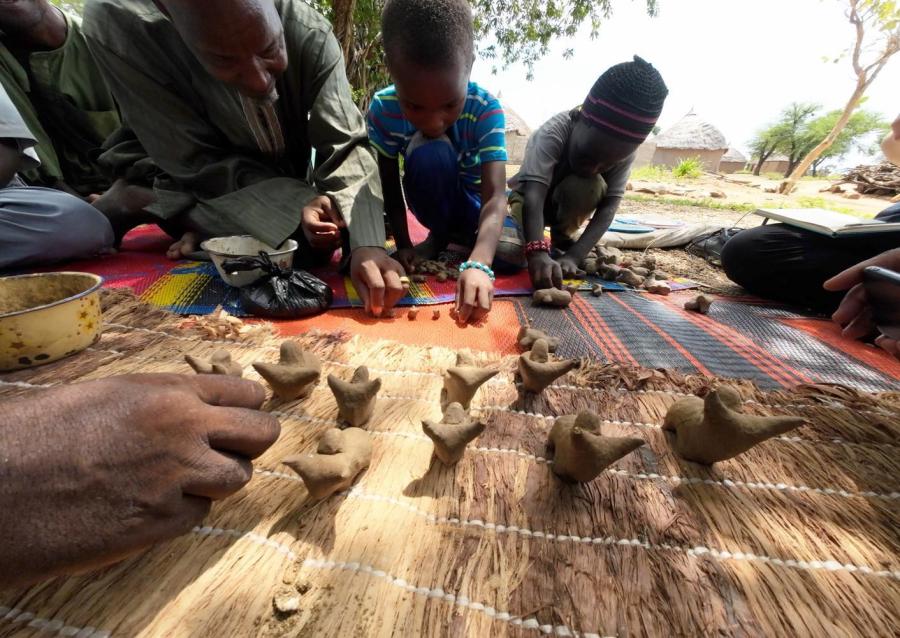Ya Habibi!” I was tackled and lifted my off my feet in a bearhug embrace. I hadn’t seen Helima in seven years, since I’d last visited my father’s archaeology site in northern Sudan, and she hadn’t changed a bit. Barging through the house door with her 70-year-old wiry frame, her grin reached from cheek to cheek. Wrapped in neon designs and bubbling with energy and laughter, she was the Sudan I remembered. Within minutes, I was on a motor bike speeding towards her shanty home for dinner.
Helima is a member of the Habassab branch of the Hawawiri people of the Bayuda Desert, a sea of living sand dunes about 200 miles north of Khartoum. Hawawir is a group name of seven different subsets of people in this part of the Bayuda Desert. The Habassab, according to several elders, came here from the north some 13 or14 generations ago. Finding the land unoccupied, they settled around wells and began settlements that have lasted until the present. Living up to six miles apart, family members retain a close-knit group claiming territory around common wells to feed their livestock—mostly camels and goats. They spend a majority of their day tending to their herds and farms. The wadi, or valley, floods from June to September, providing soil and water for beans, millet, and vegetables; camels and goats are sold in the local markets in the off-season. The Habassab rely on each other in times of drought or famine, and they rarely have more than the clothes on their back.
Travel through the Bayuda has always been by foot, camel, or car. Following previous tracks and landmarks through mountains and valleys has been a method used for hundreds if not thousands of years by desert settlers. This has allowed for continual contact, trade, and inclusion of the desert tribes with others. But things are changing fast in the Bayuda.
One morning, as my father and I prepared for our workday, 21 camels passed by walking in a line, heading to the Hawawiri well several kilometers away. Their owners, two brothers named Muhammed Ali and Abdullah, approached us with proud strides.
“Salaaaam Aliekum!” Muhammed called in a song-like voice, his arm outstretched.
“Aliekum Al-Salaaam,” came our response.
Muhammed lived a mile and a half off to the east in a small, ramshackle, mud-brick house typical of the region. In the mornings, we’d see his camels sauntering single file through the desert towards the watering hole in the distance. Some 30 minutes later, both he and his 4-year-old son would be in lazy pursuit with a herd of goats. He’d stop by almost daily to chat about his family and the changing living conditions. Despite his initial cheery grin and Sudanese hospitality, the reality of his situation eventually broke through. “Can I have your sweater?” he asked my father and me. Muhammed was direct, pointing to the heavy cloth on my chest. His slender, boney face beamed incongruously in the midday sun. It was unseasonably chilly, and the night before I could see my breath in the kerosene light. His white jelabiya shirt was tattered and stained by months of use. It was his only clothing. “My son can’t sleep at night,” he said, “and we are cold. I don’t have anything to keep me warm.”
We dug up all of the extra clothing possible between us.
He returned the next day, but we could only offer food and company, and despite his hard situation, he declined. Over the next six weeks, he and his small family spent many hours with us, excited at our new faces, and dismayed that we couldn’t ease their situation much. He told us of his increasingly difficult existence in the desert, a sad story always delivered with that incongruous smile of crooked teeth. Bayuda seasons bring searing heat, frigid cold, floods and sandstorms, all of which have been more extreme in the past few years because of a two-year drought. Worse, the Bayuda’s new highway has diverted much local traffic away from his home, leading to less trade and access to resources.
Ten years ago, asphalt began pouring onto the hot sand of the Bayuda and Nubian deserts, carving out a new commerce route from the capital to the northern cataracts of the Nile. With the building of Sudan’s first major highway and the introduction of electricity, commerce from north to south has become easier, at least for the city dwellers. But dependent on the older path for trade, the Habassab have suddenly become isolated from the world and essentially left behind, needing to travel enormous distances in order to find human contact. To compound the problem, drought and desertification in recent years have led to crop failure and decreasing food supplies. Family units and land have begun to fracture, and the highway has become the new lifeline. Small truckstops and nontraditional highway settlements have forced the desert peoples to adapt to a changing reality.
It is difficult to weigh the costs and benefits for the Habassab and other tribes deep in the Bayuda. Globalization shows no mercy, and the result usually involves a gradual erosion of traditional culture, territory, and family. Amidst declining resources, gradual desertification, and the pull of low-wage city jobs, these people are struggling to maintain their traditional economy and culture. With the northern progression of highways, electrical lines, and a burgeoning globalized economy, indigenous Sudanese culture is in flux, and a new history of the Habassab is in the making.
Alex Kendall is a photographer living in Cambridge, Massachusetts. http://www.alexkendallphotography.com/

